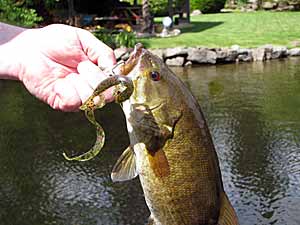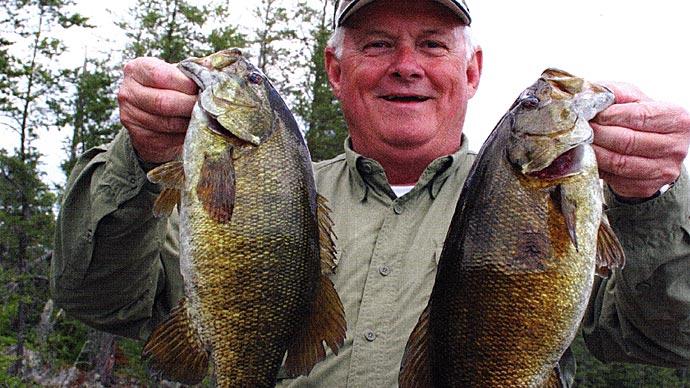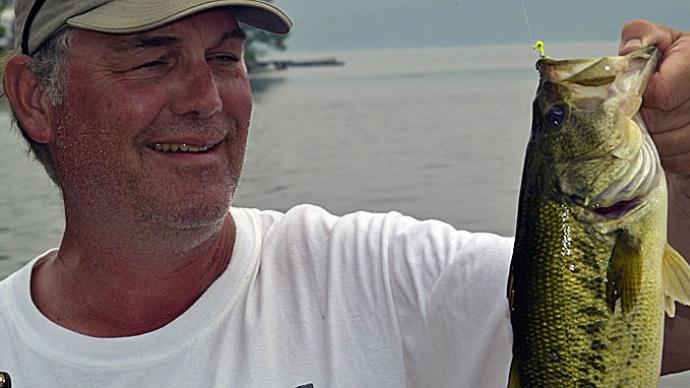
Plastic baits come in assorted colors, sizes, shapes, and types, such as floating and non-floating. In addition, there are paddle tails, gator tails, slim-line curled tails, and even some with no tails. Finally, some baits have scents added to the plastic mixture, such as salt, garlic, and anise. Whether you use the Berkley Power Baits, dip your plastics in Spike-It garlic dye, or spray the scent on your baits, I believe scented plastic baits catch more fish than unscented ones.
The versatility of plastics in fishing is unlimited. These baits can duplicate the movement of a swimming snake, be hopped across lily pads, moved slowly over grass beds, or tossed under docks. You can pitch them into buck brush and reeds, jig them at the base of trees, or retrieve them quickly across the top of the water. They can be cast out to do nothing but float lazily in the water and, when rigged correctly, even make noise.
Plastic baits are designed to resemble worms, grubs, lizards, crawfish, frogs, baitfish, and centipedes. The shape of other baits, such as the infamous French fry, do not resemble any living creature, but bass will gobble them.
Worm fishing does not have to be boring for the impatient person. It isn't necessary to let the worm sit until the bass takes the bait. However, there are times this technique works when nothing else will.
Think of the bass as a cat. If you move the string (bait) a little, it catches the attention of the cat (bass). Slowly change the string's direction, shake it, and let it sit for a moment. The cat will watch the string, and if you are persistent, the cat will attack the string. Bass react similarly. This method works well when fishing plastics, and the bass seems to have lockjaw.
When it's feeding time for that cat, the sound of a can opener brings the cat to you faster than trying to call it for food. Put a rattle, either glass with beads or metal, in your plastic bait. Shake your rod gently, and the rattle will cause sound waves under the water. A hungry bass will investigate and inhale your plastic bait.
Speaking of inhaling, bass do not bite. They inhale your bait. They open their gills and inhale water along with your bait. There are times when the bass are aggressively feeding that you can feel a yank or pull on your line. When this occurs, the bass is inhaling your bait. Set the hook quickly. Other times, your line will feel mushy, as though you are pulling your bait through slimy grass. Set your hook! It's probably that giant bass you've been trying to catch.
When you fish with artificial baits, you must know the type of structure you'll be fishing in. Grass beds, rocks, points, reeds, brush, timber, ledges, and docks are some of the structures you will fish. The plastic baits you use fishing these structures differ because of the shape and body of the tail. Gator tail worms and grubs have broad tails and leave a wake in the water as you reel in the line. This action attracts the bass fishing sandy or clean bottom waters, murky water, and grass. Even though the gator tail catches in the grass, the vibration of the large tail attracts the bass. This type of tail is also more visible to the fish under certain conditions.
Slim-tailed plastics such as worms, Slug-gos, and lizards are used when you fish the edges of grass beds, trees, brush piles, and reeds. This tail slides around and over logs and will not hang up as easily as the gator tail in the same structure.
Paddle-tailed baits are effective when fishing over grass. The small paddle creates a waving action under the water, getting the attention of the bass hidden under the grass. It does not get hung up as easily as the gator tail.
Types Of Plastic Baits
The centipede, ring fry, and bubble fry have the profile of a caterpillar. Either end can be used as the head when placing it on your hook. When the plastic no longer stays on the hook, the bait can be turned upside down, placed on the hook, and used again. This can be extremely helpful when the bass are taking only that color of plastic, and it's the last one you have. The rings on these baits hold air; when you fish with them, air escapes, creating air bubbles under the water that attract bass. These baits are used on Carolina and Texas rigs. They can also be fished using a split-shot weight, light line rig, or with no weight because they are heavier baits. When setting the hook, I prefer using a #3, wide-gap, offset hook with these baits for maximum penetrations.
Plastic frogs hopped over lily pads can give you a jolt as good as any topwater bait. Sometimes when the frog slides over the pad and is allowed to sit on the edge, a bass will come straight up out of the water to try and eat that frog. Don't set the hook until you feel the bass tug down. It's difficult to stop your immediate reaction to setting the hook, but if you do not wait, you might yank the bait away before he can chomp down on it. Use a weed guard-type hook for protection from hooking lily pads and stems, or embed the point and barb of the hook into the back of the frog to make it weedless.
Fishing with lizards, a spawning bass' natural enemy, can be done year around. They can be purchased in any size and color you like to fish with. Notice the colors the live lizards are sporting for each season and match the hatch with your plastics. Remember, lizards can sit still, run, turn, stop and start on a dime. Using lizards in heavy cover can be tedious, but worth the patience it takes to catch bass in brush, reeds, and heavy grass. If you fish this bait in deep water, the bass will try to kill and eat the lizard as in shallow water. Therefore, people tend to utilize lizards only in the spring. But year around use of these baits can be very productive, just as they are in the spring. Lizards are usually fished using a Carolina or Texas rig.
Grubs and gitzits are typically fished on lighter line. Using a jig-headed hook, thread the bait on the hook and cast it under a dock, near the bank, on a point, or around the pilings of bridges. Allow the bait to slowly arch back to your boat, keeping contact with your line so you can feel the strike. You can also hop these baits on the bottom or swim them under the water toward you. Use a hook size slightly smaller than the length of the body of the plastic, allowing the tail to move freely in the water. Some people bend the hook's point and barb out for an easier hook set. Grubs can, and should be, included in your list of Carolina rig baits to fish with.
Crawfish are a bass's filet mignon. Their little, snapping claws will call a bass as quickly as a can opener will a cat. Put a rattle in the body of the crawfish, and Texas rig the bait. You can also place a glass bead between the weight and the hook for an added clicking noise. Crawfish can be found near rocks, sand, and grass. When they are on the defense against an enemy, they move backward. Put the bait on your hook so the claws will face you when retrieving the bait. Retrieve this bait slowly toward you. Shake your rod tip, then move the bait again. Change the pace of movement occasionally so the bait will seem alive. Watch the color of the crawfish change each season, and use that knowledge when fishing with your plastic crawfish. Crawfish are probably fished more with jigs than solo. Jigs give bulkiness to the bait that attracts larger bass. They are very effective at night and fished on a Carolina rig.
Do nothing, free-floating stickbaits, Bass Assassins, flukes, and Slug-gos are fun to fish. These baits are formed to resemble baitfish and snakes. They can be fished in open water, over grass beds, near bridge pilings, under docks, deep and shallow water, through trees, near reeds, bushes, and grass lines. Depending on your fishing structure, you can fish them with or without weights. To fish these baits, cast out and let the bait move slowly through the water, twitching your rod occasionally to keep the bait moving. You will feel a tug on the line, so you will know when to set the hook. You can also use these baits on a Carolina rig or cast the bait into the schoolers if it is schooling time for the fish. Again, be ready to set the hook when the tug occurs.
To place the jerkbaits on your hook, stick the hook's point into the head of the bait about ¼-inch deep. Bring the hook through the plastic until the head of the bait reaches the offset top of the hook. Next, turn the hook toward the belly of the bait. Measure the length of the hook to the body of your bait. Where your hook's body meets the bait's body is where you stick the hook's point through the plastic. Now, slowly pull the hook's shaft back toward your hand. When and where the hook's barb is close to the bait, gently pinch upward on the plastic bait, and cover the point and barb of the hook with the plastic. You now have a weedless lure. You can use this same technique when putting most plastics on a hook.
The French fry is my personal favorite. To me, watermelon seed dipped in Spike-It chartreuse garlic scent is a killer bait. I fish this particular plastic year around, outside and inside grass beds, in shallow and deep water, with the same good results. Usually, when I fish this bait, I will use light line with a #7 split shot on a spinning reel if the wind is not blowing too hard. I change to a #5 split shot if the wind picks up. Keep the line loose and watch it carefully. When the line begins to move, crank up the line, and set the hook. You can fish this bait on heavy line, Carolina rigged and wacky style.
Hooks, Weights, and Rigs
The hook size you use depends upon the size and shape of the plastic baits you are fishing. Using off-set hooks will help eliminate the plastic sliding down the hook shaft. Wide gap hooks should be used when fishing the thicker plastic baits. The thicker plastic baits, such as frogs, flukes, Slug-gos, and Bass Assassin, will bunch up on a regular worm hook. Getting a good hook set is hard if you don't straighten it out. The weedless hook is typically used for fishing grubs, gitzits, and frogs. This particular hook helps protect the barb from snagging in heavy vegetation. There are several ways to rig plastic baits.
Carolina rigs have a weight either pegged or separated by a swivel, 12 inches to four feet from the hook. If you are fishing deep water, I suggest using the swivel. If your hook gets snagged, you will usually lose the leader, not the weight. Keep extra leaders with the hooks attached to your boat's zip-lock bag, and you can quickly re-tie your Carolina rig. The hook size you use depends upon the size of the plastic bait you are fishing, so store different size hooks on those leaders in the zip lock bag. Remember, the larger the bait, the larger the hook.
A Texas rig places the weight just above your hook. This technique works well in water up to just over 20 feet deep, depending on your fishing structure. For example, if you are jigging in deep point grass beds, use the Texas rig because it keeps contact with your slim tail or gator tail worm. In addition, using the Texas rig under these conditions makes it easier to feel a fish on your line.
The shape of the weight must also be considered. If the structure you will be fishing for has a sandy, clean bottom or grass, you can use a bullet weight. Use a barrel-shaped weight if there are rocks or tree roots. It will roll over these obstacles better. If you are fishing light line, I suggest using the Mojo weights. It can be easily removed and replaced with a lighter or heavier weight when the wind stops blowing or increases in strength.
A wacky-style rig does not have a weight on the line. Tie your straight-line hook or weedless hook on the line. Push the point through the middle of the plastic bait, cast out the line, and let the bait move in the water either with the water movement or your rod tip. Because the weight is missing, your bait should not bog down coming across grass. Some people place a headless nail in the worm's head to help it fall more quickly.
Plastic manufacturers create new shapes, styles, and colors for baits each year. All of them will catch fish. Just remember that oldies can be goodies to the bass. Your imagination is the only limitation of how, where, when, and which plastic to use to catch bass.
BassResource may receive a portion of revenues if you make a purchase using a link above.




